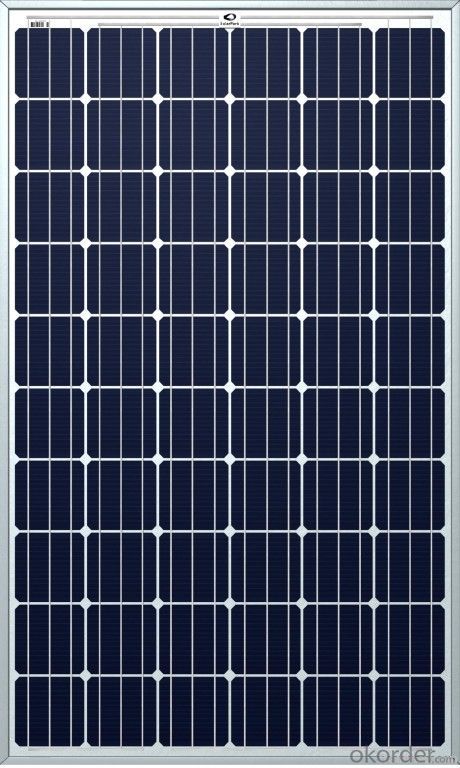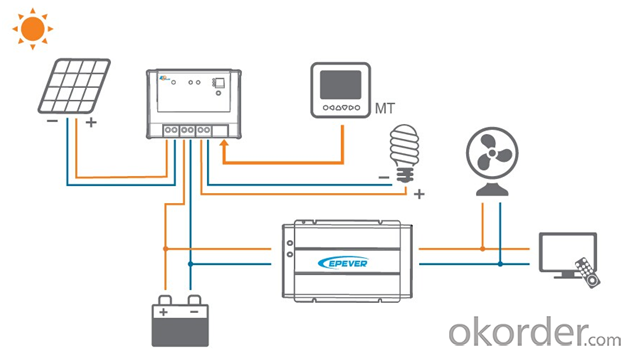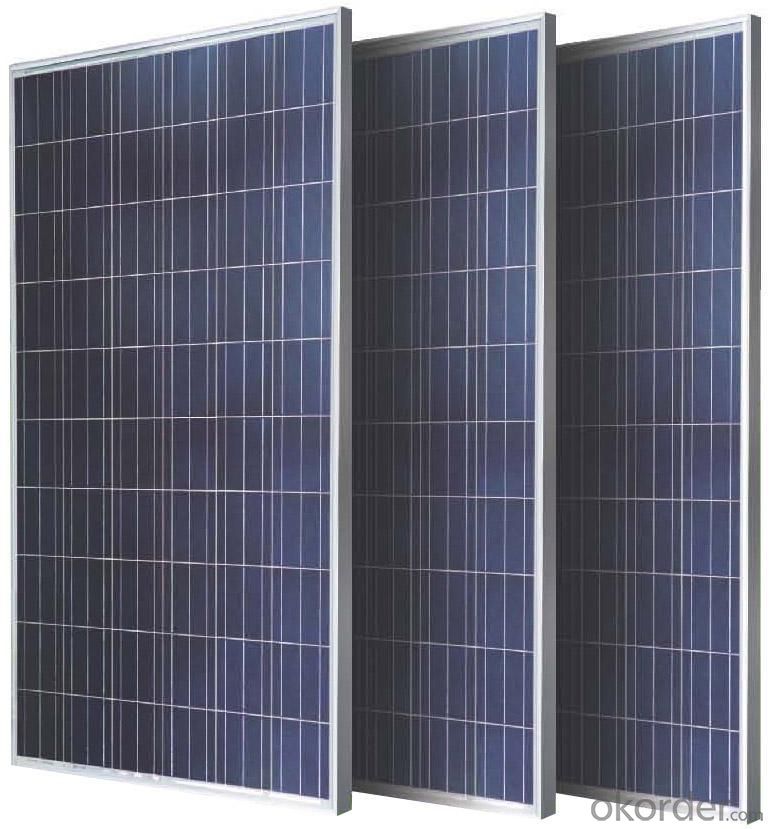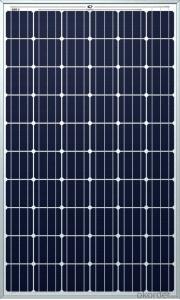300W Mono & Poly 260W/ 265W/270W/ 280W/300W/310W High Efficiency Solar Module
- Loading Port:
- Shanghai
- Payment Terms:
- TT OR LC
- Min Order Qty:
- 1000 watt
- Supply Capability:
- 10000 watt/month
OKorder Service Pledge
OKorder Financial Service
You Might Also Like
Item specifice
Features
1) Product name: solar panel / module
2) Solar cell: Mono-crystalline / Poly-crystalline / Amorphous
3) Tempered glass laminated with aluminum frame
4) Life time: 20 - 25 years
5) Temperature co-efficiency: A=+1,46mA B=-79mV, Rp/p=-0.43
6) Power specification at 1kW/m 2, AM 1, 5
7) Output cable: multi contact connectors
8) Construction:
a) Front: High-transmission 32mm tempered glass
b) Back: TPT
c) Encapsulant: EVA
9) Frame: aluminum
10) Certification: CE, TUV
Specification
STC | BSM230P-60 | BSM235P-60 | BSM240P-60 | BSM245P-60 | BSM250P-60 | BSM255P-60 | BSM260P-60 |
Maximum Power | 230W | 235W | 240W | 245W | 250W | 255W | 260W |
Module Efficiency | 14.10% | 14.35% | 14.66% | 14.96% | 15.30% | 15.60% | 16.00% |
Maxi Power Current | 7.62A | 7.72A | 7.895A | 8.033A | 8.23A | 8.31A | 8.47A |
Maxi Power Voltage | 29.5V | 30.2V | 30.4V | 30.5V | 30.4V | 30.6V | 30.7V |
Short Circuit Current | 8.31A | 8.59A | 8.718A | 8.781A | 8.81A | 8.84A | 8.93A |
Open Circuit Voltage | 36.8V | 36.8V | 37.2V | 37.2V | 37.6V | 37.7V | 37.8V |
Power Tolerance | 0~+5W |
| Values at Standard Test Conditions STC(Air Mass AM1.5,Irradiance 1000W/m²,Cell Temperature 25℃) | |
| Mechanical Characteristics | |
Cell Type | Polycrystalline 156x156mm,60(6x10)pcs in series |
Glass | High Transmission,Low Iron,Tempered Glass |
Frame | Anodized Aluminium Alloy |
Junction box | IP65/IP67 rated,with bypass diodes |
Dimension | 1640x990x35/40mm |
Output Cable | 4mm2(EU)/12AWG(US),1000mm² |
Weight | 19Kg |
Installation Hole Location | See Drawing Above |
No.of Bypass Diodes | 3/6 |
Images




Packaging & Shipping
What is the packing?
1.Package: Carton Box for packaging, or Wooden Box advised for Samples to protect in transportations. Package designed by Clients is welcomed.
2.Shipping: DHL,FEDEX,UPS,EMS,AirWay and By Sea.
3.Payment: T/T( telegraphic transfer (T/T) and Western Union
4.Welcome to your Sample Order to test First.
FAQ
Q1: How to choose a right inverter?
A1:Tell us your demand, then our sales will recommend a suitable inverter to you.
Q2: What's the different between inverter and solar inverter?
A2: Inverter is only accept AC input, but solar inverter not only accept AC input but also can connect with solar panel to accept PV input, it more save power.
Q3: How about the delivery time?
A3: 7 days for sample; 25 days for bulk order.
- Q:i would like to hook up a power outlet to a solar panelmy light system is 500watts will run for 8 hours/day between noon to 8PM.So what is the most effective system do I need?
- Most efficient manner would probably be to use solatubes, or sun tunnels during lighting hours, then replace the 500 watt lighting system (assuming it's incandescent) with LED's, that should give you about the same light output for around 00 watts or a little less even. Then you need a solar panel that can produce 00 watts for as long as you want (at a 00 watt lighting system) or 200 watts for /2 the time you want, etc, etc. Allow a good 0% or so for inverter inefficiencies, and 0% or so for reserve, so 20 watt's per 00 watts. After you have this, you will want a charging controller, a battery, or battery bank (These should at very least be deep-cycle, or better yet golf-cart batteries with series between 2, and parallel between banks of 2 for the 2-volt portion of the system), with enough amp-hours to support your system, plus a good 0% or so reserve, plus another 0% or so for inverter inefficiencies (remember the over sized solar panel above, this is why), than of course you also need a 2-volt DC to 20-volt AC, 60 Hz system (or 240 volt AC 50 Hz system, depending on your AC system) inverter.
- Q:How do solar panels affect the roof's integrity?
- Solar panels generally do not affect the roof's integrity when installed properly. In fact, they can even extend the roof's lifespan by providing protection from elements like sunlight, rain, and snow. However, it is crucial to hire experienced professionals for installation to ensure proper mounting and sealing, avoiding any potential damage to the roof.
- Q:Can solar panels be used to power an emergency response center?
- Yes, solar panels can be used to power an emergency response center. Solar panels convert sunlight into electricity, which can be stored in batteries or directly used to power the center's equipment, lighting, and other electrical needs. This can provide a reliable and sustainable source of power, especially during emergencies when the grid may be down or unreliable.
- Q:Can solar panels be installed on a high-rise building?
- Yes, solar panels can be installed on a high-rise building. In fact, high-rise buildings can be ideal locations for solar panel installation due to their height and large surface areas. By utilizing the available roof space, high-rise buildings can generate significant amounts of solar energy, helping to reduce their reliance on traditional energy sources and lowering their carbon footprint.
- Q:Can solar panels be installed on government buildings?
- Yes, solar panels can be installed on government buildings. In fact, many governments around the world have already embraced solar energy and installed photovoltaic systems on their buildings as part of their commitment to renewable energy and sustainability. This helps reduce the carbon footprint of government operations and serves as a positive example for the community.
- Q:if you know the area of the panel can u calculate for the wattage or voltage of the panel..
- You need to know how many solar cells are in the panel and what is the rated current each cell will produce. This information should be listed on the panel. Each cell will produce from 0.5 to 0.55 volts DC per cell and each cell will produce a current that is dependent on the size of the cell and the type of material the cell is made from. If the cells are connected in series then the voltage of each cell will add together, that is if you have 30 cells connected in series they should generate about 5 to 6.5 volts DC. If each cell generates .2 amps, then you multiply the voltage of 5 volts DC times .2 amps DC equals 8 watts of power. The current of each cell does not add together when you connect the cells in series only the voltage of each cell. If you connect the 30 cells in parallel then the current of each cell adds together but the voltage of each cell does not. That is 0.5 Volts DC times 36 amps equals 8 watts. The power (watts) produced will be the same. See our blog on the products page to see how to connect solar cells in series and in parallel. We also have a PDF file of solar cells and their rated output current sorted by watts per area and their manufacturer.
- Q:How do solar panels affect the property's long-term financial viability?
- Solar panels can significantly enhance the long-term financial viability of a property. By generating clean and renewable energy, solar panels can help reduce electricity bills, providing substantial savings over the life of the system. Moreover, investing in solar panels can increase the property value, making it more attractive to potential buyers and potentially resulting in higher resale prices. Additionally, solar panels can provide a stable and predictable source of electricity, protecting the property from future energy price fluctuations.
- Q:if i was to put a solar panel (sp) just outside of the earths atmosphere ans another solar panel (sp2) 0km away towards the sun. which one would generate more power (sp or sp2)? and how much more? is there a ratio to work out the power output and distance from the sun? would the 0km distance between the panels make a large difference in power output?many thanks in advance
- Given identical panels the one closer to the sun would generate more power, but a difference of only 0 km at 93 million miles, the difference would be very small. Light intensity is inversly perportional to the square of the distance from the source.
- Q:Are there any government incentives or tax credits for installing solar panels?
- Yes, there are government incentives and tax credits available for installing solar panels. These incentives vary by country and region, but they often include federal tax credits, state or provincial rebates, and local grants or loans. These financial incentives aim to promote the adoption of renewable energy sources and help offset the initial costs of installing solar panels. It is advisable to consult local authorities or renewable energy organizations to learn about specific incentives available in your area.
- Q:I'm curious to know if the small solar panels on a calculator (ie TI-32) could produce a voltage similar to what is used in a single-use (disposable) camera, approximately 4V.
- Build okorder /
1. Manufacturer Overview |
|
|---|---|
| Location | |
| Year Established | |
| Annual Output Value | |
| Main Markets | |
| Company Certifications | |
2. Manufacturer Certificates |
|
|---|---|
| a) Certification Name | |
| Range | |
| Reference | |
| Validity Period | |
3. Manufacturer Capability |
|
|---|---|
| a)Trade Capacity | |
| Nearest Port | |
| Export Percentage | |
| No.of Employees in Trade Department | |
| Language Spoken: | |
| b)Factory Information | |
| Factory Size: | |
| No. of Production Lines | |
| Contract Manufacturing | |
| Product Price Range | |
Send your message to us
300W Mono & Poly 260W/ 265W/270W/ 280W/300W/310W High Efficiency Solar Module
- Loading Port:
- Shanghai
- Payment Terms:
- TT OR LC
- Min Order Qty:
- 1000 watt
- Supply Capability:
- 10000 watt/month
OKorder Service Pledge
OKorder Financial Service
Similar products
New products
Hot products






























